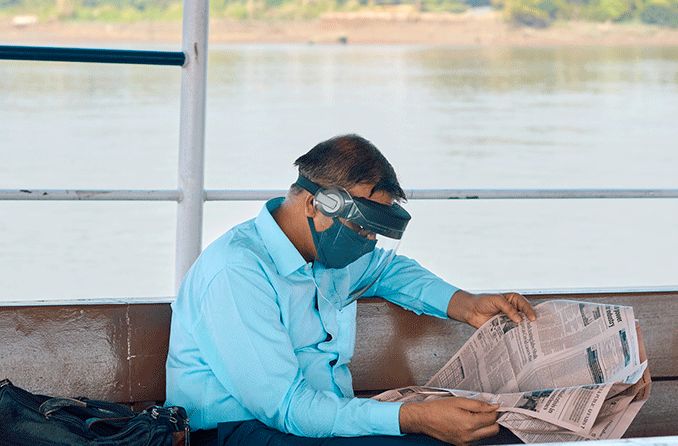Wearing a mask keeps you safer from COVID-19 than wearing a face shield or goggles

With variants of the coronavirus developing, it’s becoming increasingly important to take necessary steps to protect yourself and your family from catching the contagious illness.
While many people believe wearing a face shield is the best way to protect against the virus, it’s important to know that by itself, a face shield does very little to keep you safe. Pairing a face shield with a face mask and maintaining social distancing are the most effective ways to keep yourself healthy.
How face shields prevent the spread of COVID-19
COVID-19 is spread through infectious respiratory droplets that are released through coughing, sneezing and talking. In theory, a face shield should block those particles from being breathed in and infecting the host.
While face shields may add extra defense when paired with a face mask, they offer little protection when used on their own. According to the Center for Disease Control and Prevention, the point of a face shield is to protect the eyes of the person wearing it, not their mouth or nose.
Face shields sit several inches away from the face, leaving large gaps in coverage near the nose and mouth. These gaps allow for infectious droplets to be expelled, exposing others to infection, or inhaled and potentially infecting the person wearing the shield.
Does a face shield replace wearing a mask?
No. Wearing a face shield does not replace wearing a mask. A study published in December 2020 used a cough aerosol to replicate how we spread respiratory droplets when we cough. They tested various face coverings to see how effectively each of them blocked the aerosol.
It was concluded that wearing an N95 mask was the most effective at filtering out harmful particles, as it blocked 99% of the aerosol. While a medical procedure mask, cloth mask, and a single- and double-layer gaiter filtered similar, lesser percentages than the N95, all of them blocked cough aerosols significantly better than the face shield.
The study proved that wearing a face shield without also wearing a mask only blocked 2% of the aerosol particles, making it fairly useless at protecting against COVID-19 when used alone.
The best way to prevent the spread of COVID-19 is to wash your hands frequently and avoid being around people who are sick. If you must leave the house for something essential, such as going to work or buying groceries, wear a mask over your nose and mouth and maintain six feet of distance between you and other people.
As the second wave hits India, many experts are advising to go for the double-mask approach, as it helps in the reduction of COVID-19 transmission. “A recent study at the Centre for Disease Control and Prevention (CDC) states that if everyone double-masked, Covid exposure can be reduced by 96.4 per cent,” Dr. Kirti Sabnis told India Today.
SEE RELATED: Are red eyes a coronavirus symptom?
Where to buy a face shield in India
There are many places to buy a face shield online in India. The price depends on the brand and where you purchase it from.
Studds, a popular helmet brand, started making face shields in response to the global coronavirus pandemic. You can purchase two different face shields from the Studds website: A flip-up face shield for INR 450 or a regular face shield for INR 350.
Face shields on Amazon come in a variety of styles and range from INR 52 to INR 1750.
The option with greater value and better protection is to invest in some quality face masks to wear in addition to your shield. Amazon sells 100-count disposable masks for INR 499, and a 10-pack of cotton reusable face masks for INR 399. You can also purchase face shields from other e-commerce sites like Flipkart, Myntra, among others.
COVID-19 and eye goggles
As mentioned earlier, the purpose of a face shield is to protect the eyes. While eye goggles could also accomplish this, eye protection may only be necessary for individuals who spend time near those who are infected, such as medical workers.
In a study published by the Centre for Evidence-Based Medicine, they found that wearing goggles would prevent the slight chance of eye exposure to infectious, airborne respiratory droplets.
Those infected with COVID-19 rarely showed eye-related symptoms, and conjunctival fluid only occasionally provides a positive result for COVID-19. However, the eyes — like other mucous membranes — could be exposed to the virus when working closely with an infected individual.
Because of the scarcity of personal protective equipment (PPE) and the rare nature of contracting COVID-19 through the eyes, protective goggles are recommended only for members of the medical community. Assessing and treating infected individuals puts medical workers at a higher risk of becoming infected, which is why protective goggles and face shields are necessary.
With this in mind, it’s important to note that eye protection is not effective on its own. Wearing eye goggles in addition to a protective face shield and mask is an effective way to block out infectious droplets and reduce the spread of COVID-19.
READ MORE: Contacts vs. glasses: Which reduces the risk of coronavirus?
COVID-19 overview and infection prevention and control priorities in non-US healthcare settings. Centers for Disease Control and Prevention. February 2021.
Guidance for wearing masks. Centers for Disease Control and Prevention. April 2021.
Efficacy of face masks, neck gaiters and face shields for reducing the expulsion of simulated cough-generated aerosols. Aerosol Science and Technology. January 2021.
Amid Covid surge, double mask for double protection? Medical expert shares advice. India Today. April 2021.
What is the efficacy of eye protection equipment compared to no eye protection equipment in preventing transmission of COVID-19-type respiratory illnesses in primary and community care? The Centre for Evidence-Based Medicine. January 2021.
Page published on Friday, 21 May, 2021





